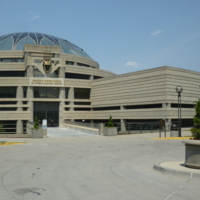
Charles H. Wright Museum of African American History
The museum was established by Dr. Charles Wright, an obstetrician and gynaecologist who envisioned an institution to preserve Black history after visiting a memorial to Danish World War II heroes in Denmark. It opened in 1965 as Detroit’s first international Afro-American museum. After expansions in 1978 and 1992, the museum was finally named the Charles H. Wright museum after its founder in 1998. It has since received monetary support from individuals, foundations, corporations, and government sources. The mission statement of the museum is to open minds and change lives through the exploration and celebration of African American history and culture.
Current exhibitions on display in the museum include a large 22,000 square-foot exhibition that examines Ancient and Early Modern African history and the experiences of the enslaved during the Middle Passage, alongside the experiences of those who resisted the horrors of bondage and self-emancipation. Throughout this exhibition, entitled ‘And Still We Rise: Our Journey Through African American History and Culture,’ there is a clear emphasis on the efforts of the everyday African American people who built families, businesses, educational institutions, and civic organisations in Detroit, past and present. The museum also offers exhibitions that look at the contributions of African Americans in science and technology, as well as showcasing examples of stained glass art by Samuel A. Hodge.
The museum has a busy events programme that includes community health and fitness programs, as well as lectures and education sessions for both children and adults. There are group tours for all ages, as well as led workshops for pre-school children. All of these workshops aim to highlight the lessons portrayed in the ‘And We Rise’ exhibition, prompting reflection and discussion from visitors.
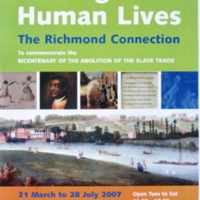
Trading in Lives: The Richmond Connection
This exhibition and education programme explored connections between transatlantic slavery and the London Borough of Richmond. This included a study of the West Indies connections in Richmond, local residents involved in abolition, and the historical presence of black people in the area. It also examined the slave forts on the coast of Ghana. 'Richmond Voices' introduced local residents who were of African or African-Caribbean descent. The accompanying booklet was written by Valerie Boyes, and produced in collaboration with the Richmond Local History Society.
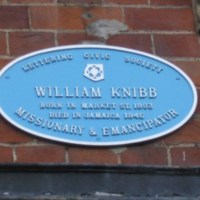
1807-2007: End of Slavery?
Manor House Museum in Kettering, in collaboration with local community groups, produced a touring exhibition which explored Kettering's involvement with the anti-slave-trade movement and issues of modern day slavery. The museum focused in particular on the life of William Knibb (1803-1845), a missionary from Kettering who taught slaves in Jamaica in the 1820s against the will of local slave owners and toured Britain speaking out against slavery. The museum produced a loans box containing material relating to Knibb and continues to have a permanent display dedicated to the missionary.
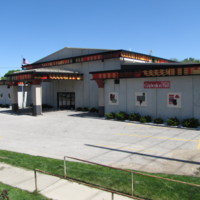
African American Museum of Iowa
The African American Museum of Iowa was founded by a small group of members of the Mt. Zion missionary Baptist church in Cedar Rapids in 1993. The museum was closed for a year during flooding, reopening in 2009. It attempts to preserve, exhibit, and teach the African American heritage of Iowa. The museum aims to examine Iowa’s African American history, from the transatlantic slave trade until Civil Rights. The museum also offers traveling exhibits available for to rent for two weeks at a small cost. It is heavily funded by donations.
The permanent exhibits at the museum are concerned with tracing Iowa’s African American history, from its origins in western Africa to the present, through slavery, the Civil War, the Underground Railroad, segregation and the Civil Rights Movement. There is also a rolling programme of temporary exhibitions on a range of themes including, art and social history. Group tours are offered for adults. These last around 45 minutes and provide additional stories, contexts, and insight into the workings of the museum throughout the tour. For younger people the museum runs field trips and hands-on workshops offering age-appropriate lessons covering local African American history and culture. There is also an online collection which includes archives, photos, library items, and oral histories.
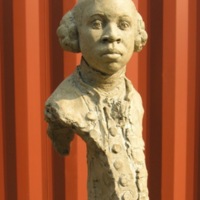
OLAUDAH EQUIANO - African, slave, author, abolitionist
This sculpture of the abolitionist Olaudah Equiano was made by London-based sculptor Christy Symington in 2006 to mark the bicentenary of the abolition of the British transatlantic slave trade, with the intent to further share Equiano's story. It was first exhibited by selection at the Society of Portrait Sculptors 'FACE 2007' annual exhibition. The sculpture portrays Olaudah Equiano’s social standing through his clothing and hairstyle which was unusual for a black man in that time. The continent of Africa is implied by the shape of the back of his shoulders arrived at by chance whilst modelling. Broken shackles and chains are sculpted down the side of the sculpture, prompting his opposition to slavery as an abolitionist and his path to freedom. The Brookes slave ship diagram and an enlarged detail of a single enslaved female figure from the diagram are found on the stem of the sculpture - a reminder that there were women and children on the ships as well as men.
Since 2007, the sculpture has featured in several other exhibitions including a solo 'OLAUDAH EQUIANO MAN AND BROTHER' at the Stephen Lawrence Centre Gallery (2015); 'Black Georgians: The Shock of the Familiar' at the Black Cultural Archives (2016); 'Revelation of the Head' at Messums Wiltshire (2018); 'Untold Stories: A Celebration of Black People in Kent' (2018); Royal Society of Sculptors Members' 'Summer Exhibition' (2018); and Salon d'Automne Paris (2019). There is a bronze edition and in 2017 a black and white duo edition (featured in exhibition 'OLAUDAH EQUIANO in BLACK and WHITE' at SPACE). The bronze sculpture is now in the permanent collections of the International Slavery Museum in Liverpool (2017), Royal Museums Greenwich (2018) and Parliament UK (2019).
Photos: Tontxi Vazquez / Sylvain Deleu © Christy Symington MRSS/DACS 2019
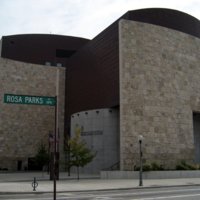
National Underground Railroad Freedom Centre
The National Underground Railroad Freedom Centre opened in August 2004 and has since strived to tell the stories of those who have fought for freedom from the Underground Railway to the present day in the hope of challenging people’s ideas about inclusivity and freedom. The museum also aims to encourage and inspire people to promote and work towards freedom. Its position next to the Ohio River is a poignant reminder of its purpose as this river separated the southern slave states from the free states of the North. The National Underground Freedom Centre examines America’s heritage alongside discussions of contemporary slavery and human trafficking. It also forms part of a group of 'Museums of Conscience' alongside three others across the United States, including the United States Holocaust Memorial Museum. The National Underground Railroad Freedom Centre reveals stories about freedom’s heroes: the men, women and children who challenge inequities to pursue greater freedom for their brothers and sisters. Through a series of rolling ‘special exhibitions’ and its vast collections displayed in several permanent exhibition spaces, the museum highlights the long history of enslavement in America, and its continuing legacy in the modern world.
The centre's most significant artifact is an original slave pen (or prison) originally built in 1830, and thought to be the only surviving example in the world. Visitors can walk through the pen and see some of the names of the people who were once held there. Alongside the pen, which is housed in its own exhibition space on the museum's second floor, there is a permanent exhibition, 'From Slavery to Freedom.' This exhibition covers three hundred years of slavery from its introduction to the Americas to its abolition. 'From Slavery to Freedom' is funded by the Oprah Winfrey Foundation and features a range of collections, including artefacts, archaeological specimens and paintings.
The centre also houses the 'world's first museum-quality, permanent exhibition on the subjects of modern-day slavery and human trafficking'; 'Invisible: Slavery Today' uses the experiences of five individuals who have been caught up in different forms of contemporary slavery and exploitation to highlight the issue in the modern world, as well as including examples of modern antislavery work around the world.
The centre also contains examples of interactive exhibits, with films, hands-on activities and live gallery talks, aimed at providing their visitors with a multi-sensory experience.
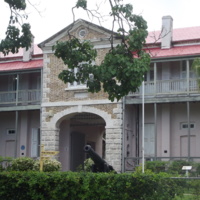
Barbados Museum and Historical Society
The Barbados Museum and Historical Society was founded in 1933. It is a not-for-profit, non-governmental organisation which aims to collect, preserve and interpret Barbadian heritage for its communities. Housed in a former prison, the museum now holds a collection of around half a million objects, dating from prehistory to today, as well as a significant archive.
The museum's permanent galleries explore the history of Barbados and its people through a range of different themes, including social, natural and military history. Colonialism and slavery feature as key themes in several of these galleries. In the Jubilee Gallery, which contains items relating to social history, the exhibition narrative charts four thousand years of Barbadian history. This includes the development of Barbados into a plantation society, life for the enslaved on those plantations and their lives post-emancipation. The Charles A. Robertson African Gallery also reflects on the legacies of slavery with regards to the African diaspora and its heritage within the Caribbean. Here the focus is on the processes of the slave trade, particularly the forced movement of people to the island. Objects in this exhibition reflect different African kingdoms, traditional customs and the diversity of African people.
In addition to its permanent exhibitions the museum also offers a range of learning opportunities relating to the history of slavery in the area. From educational island tours, to school visits and a programme of public events, the museum caters for a wide range of audiences.
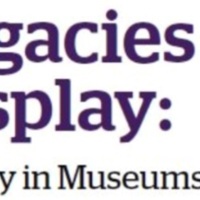
Hanover Museum
The Hanover Museum dates back to the eighteenth century, and is housed in a former slave prison. It was redeveloped in 2011 and now stands as an important symbol of resistance to the people of Jamaica. Situated in the small town of Lucea, between Montego Bay and Negril, the museum sits within a wider landscape of Georgian colonial architecture. Other buildings of historical significance include the nearby church and Fort Charlotte.
The museum houses a varied collection charting the development of the town from the period of plantation slavery to Jamaican independence from British rule. There are paintings, pottery and other artefacts that showcase what life was like for the enslaved. There are also instruments, including stocks, whips and shackles, that highlight the brutal nature of enslavement. In addition, the museum houses a significant collection of archival material, including plantation records and accounts, as well as an early, hand-drawn map of the harbour and surrounding area by Captain William Bligh.
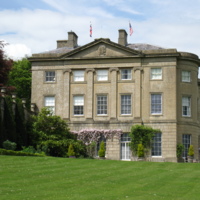
American Museum & Gardens
The American Museum in Britain is housed in a manor house, built in 1820 by English architect Sir Jeffry Wyatville. It is the only museum of Americana outside the USA and was founded to 'bring American history and cultures to the people of Britain and Europe'. It uses a rich collection of folk and decorative arts to interpret these traditions from America's early settlers to the twentieth century. Living history events bring these stories to life, in addition to changing temporary exhibitions which keep the narrative up to date. The museum opened to the public in 1961 as the brainchild of two antiques dealers.
The museum's collections are a rich source of furniture, portraiture and textiles from America, displayed thematically within period rooms acting as gallery spaces. The 'American Heritage' exhibition, charting the history of America through the narration of key events and people dominates a large proportion of this space. Key collections highlights in this exhibition include Martin Luther King's 'I Have a Dream' speech and a range of treasures from New Mexico.
Also contained within the 'American Heritage' exhibition is a small display about slavery and abolition in America. The main focal point of this display is a quilt made by enslaved people on a plantation in Texas. Other themes addressed here include the Underground Railroad, prominent abolitionists and the importance of the Civil War in the eventual abolition of slavery.
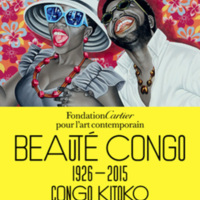
Beauté Congo – 1926-2015 – Congo Kitoko, Fondation Cartier, Paris (11 July 2015 - 10 January 2016)
A place of extraordinary cultural vitality, the creative spirit of the Democratic Republic of the Congo will be honored in the exhibition Beauté Congo – 1926-2015 – Congo Kitoko presented at the Fondation Cartier pour l’art contemporain with André Magnin, Chief Curator.
Modern painting in the Congo in the 1920s: Taking as its point of departure the birth of modern painting in the Congo in the 1920s, this ambitious exhibition will trace almost a century of the country’s artistic production. While specifically focusing on painting, it will also include music, sculpture, photography, and comics, providing the public with the unique opportunity to discover the diverse and vibrant art scene of the region.
Precursors: As early as the mid-1920s, when the Congo was still a Belgian colony, precursors such as Albert and Antoinette Lubaki and Djilatendo painted the first known Congolese works on paper, anticipating the development of modern and contemporary art. Figurative or geometric in style, their works represent village life, the natural world, dreams and legends with great poetry and imagination. Following World War II, the French painter Pierre Romain-Desfossés moved to the Congo and founded an art workshop called the Atelier du Hangar. In this workshop, active until the death of Desfossés in 1954, painters such as Bela Sara, Mwenze Kibwanga and Pili Pili Mulongoy learned to freely exercize their imaginations, creating colorful and enchanting works in their own highly inventive and distinctive styles.
Popular painters: Twenty years later, the exhibition Art Partout, presented in Kinshasa in 1978, revealed to the public the painters Chéri Samba, Chéri Chérin, and Moke and other artists, many of whom are still active today. Fascinated by their urban environment and collective memory, they would call themselves “popular painters.” They developed a new approach to figurative painting, inspired by daily, political or social events that were easily recognizable by their fellow citizens. Papa Mfumu’eto, known for his independent prolific comic book production and distribution throughout Kinshasa in the 1990s, also explored daily life and common struggles throughout his work. Today younger artists like J.-P. Mika and Monsengo Shula, tuned-in to current events on a global scale, carry on the approach of their elders.
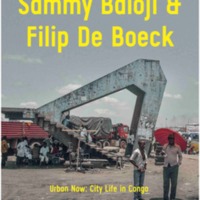
Urban Now: City Life in Congo, Various Venues (2016-2017)
This exhibition by photographer Sammy Baloji and anthropologist Filip De Boeck offers an exploration of different urban sites in Congo, through the media of photography and video. Focusing upon the “urban now”, a moment suspended between the broken dreams of a colonial past and the promises of neoliberal futures, the exhibition offers an artistic and ethnographic investigation of what living – and living together – might mean in Congo’s urban worlds.
As elsewhere on the African continent, Congo’s cities increasingly imagine new futures for themselves. Today, these new urban dreams often only manifest themselves in the form of billboards and advertisements for the city to come, inspired by Dubai and other recent hot spots from the Global South. Ironically, the city model they propose invariably gives rise to new geographies of exclusion that often take the form of gated communities and luxury satellite towns designed for a still somewhat hypothetical local upper middle class.
In sharp contrast with these neoliberal imaginings, the current infrastructure of Congo’s cities is of a rather different kind. The built colonial legacy has largely fallen into disrepair. Its functioning is punctuated by constant breakdown, and the city is replete with disconnected fragments, reminders and echoes of a former modernity that continues to exist in a shattered form. These failing material infrastructures greatly impact upon the quality of the city’s social life, and push it to the limit of what is livable. Yet Congo’s urban residents constantly engage in inventing new social spaces to bypass or overcome breakdown, exclusion, poverty and violence. Exploring these spaces, the exhibition captures a more inhabitable and inclusive urban world, where the possibilities of collective action and dreams of a shared future continue to be explored.
Curator: Devrim Bayar
The exhibition is organized in collaboration with and will travel to Galerias Municipais/EGEAC, Lisbon, and The Power Plant, Toronto.
With the support of the Research Fund of KU Leuven and Imane Farès Gallery, Paris.
In collaboration with Kunstenfestivaldesarts & Summer of Photography 2016.
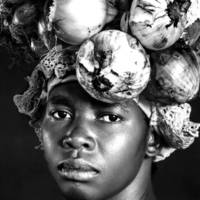
Women of the Congo: Photography of Isabel Muñoz and Concha Casajús, Museo Nacional de Antropologia, Madrid (17 March - 18 June 2017)
The Democratic Republic of the Congo has been plagued by conflicts over control, extraction and distribution of natural resources such as coltan, diamonds and oil. In this exhibition, photographers Isabel Muñoz, National Photography Award 2016, and Concha Casajús present the struggle of Congolese women in the face of the use of sexual violence as a weapon of war. The show is a series of portraits and testimonies of women from Bukavu, in the province of South Kivu, in the east of the country. The exhibition aims to make the situation of these women visible, as well as the violence they suffer. But at the same time, it invites us to reflect on the way in which these women face such suffering, rejecting in many cases the status of victims and trying to survive with dignity. Many have managed to get rid of this stigma and have struggled collectively to become activists and successful women. All a song to those women who have broken the silence and, from mutual support and sorority, have become true heroines of this twenty-first century.
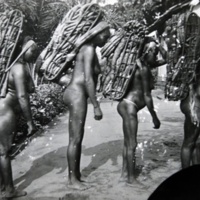
Carriers of Culture: Women, Food and Power from the Congo Basin, Museum of Archaeology and Anthropology, Cambridge University (October 2016 – March 2017)
Exploring the role of women and food from the Congo basin in the past and today, MAA’s first exhibition in our rebranded spotlight gallery is co-curated with the Congo Great Lakes Initiative.
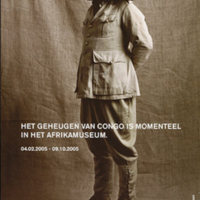
The Memory of the Congo in the Colonial Era, Royal Museum for Central Africa, Tevuren, Belgium ( 4 February 2005 - 9 October 2005)
With this exhibition, the RMCA aims to contribute to the highly topical debate concerning the colonial history of Congo and Belgium.
Visitors learn more about this controversial period through little-known objects, works of art, documents, films, and photographs. Filmed interviews with Belgians and Congolese give a voice to the past in a lively confrontation with memories and emotions. Memory of Congo, through specific themes and diverse narratives, revisits this turbulent chapter in history
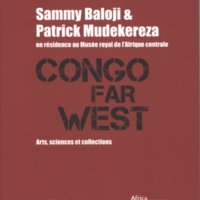
Artists in Residence. Sammy Baloji & Patrick Mudekereza,
Congo Far West, Royal Museum for Central Africa, Tevuren, Belgium (11 May – 4 September 2011)
In this exhibition the artists Sammy Baloji and Patrick Mudekereza present us with a contemporary take on the colonial past. As artists in residence in the museum they got carte blanche in the museum collections. In dialogue with scientists from the museum they have started working with a few collection pieces dating from the beginning of Congo’s colonial history. These collection pieces exhale the atmosphere of the conquest of Congolese territory by the West. The leitmotif of the exhibition ‘Congo Far West’ refers not only to this territorial conquest, but also to the contemporary Congolese artists who artistically and intellectually recapture the collection pieces conserved in the West.
Patrick Mudekereza is a writer and poet but he also writes texts for comic strips, exhibitions and audiovisual art. During his time in the museum he is working on a hybrid sculpture entitled L’art au Congo which raises a whole host of questions, and treaties signed with a cross which sealed the transfer of land from the local chefs to Leopold II. Photographer Sammy Baloji is working on a series of photographs and watercolours from a colonial exhibition led by Charles Lemaire. He has already exhibited in cities such as Paris, Bamako, Brussels, Cape Town and Bilbao. A Beautiful Time, his first solo exhibition in the United States, taking place in the Museum for African Art in New York, will be on show in in the Smithsonian National Museum of Natural History in Washington in 2012. Sammy Baloji and Patrick Mudekereza both live and work in Lubumbashi in DR Congo. Together they are organising the photography biennale Rencontres Picha in Lubumbashi, the third edition of which will take place in 2012.
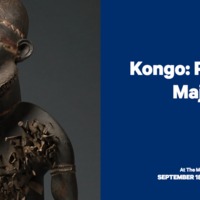
Kongo: Power and Majesty, Metropolitan Museum of Art, New York (18 September 2015 - January 3 2016)
Central Africa's Kongo civilization is responsible for one of the world's greatest artistic traditions. This international loan exhibition explores the region's history and culture through 146 of the most inspired creations of Kongo masters from the late fifteenth through the early twentieth century.
The earliest of these creations were diplomatic missives sent by Kongo sovereigns to their European counterparts during the Age of Exploration; they took the form of delicately carved ivories and finely woven raffia cloths embellished with abstract geometric patterns. Admired as marvels of human ingenuity, such Kongo works were preserved in princely European Kunstkammer, or cabinets of curiosities, alongside other precious and exotic creations from across the globe.
With works drawn from sixty institutional and private lenders across Europe and the United States, Kongo: Power and Majesty relates the objects on view to specific historical developments and challenges misconceptions of Africa's relationship with the West. In doing so, it offers a radical, new understanding of Kongo art over the last five hundred years.
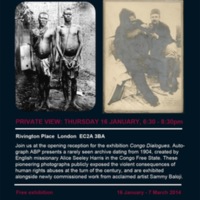
'When harmony goes to hell'. Congo Dialogues: Alice Seeley Harris and Sammy Baloji, Rivington Place, London (16 January - 7 March 2014)
Autograph ABP presents a rarely seen archive dating from 1904, created by English missionary Alice Seeley Harris in the Congo Free State. These pioneering photographs publicly exposed the violent consequences of human rights abuses at the turn of the century, and are exhibited alongside newly commissioned work from acclaimed contemporary Congolese artist Sammy Baloji.
In the early 1900s, the missionary Alice Seeley Harris produced what was probably the first photographic campaign in support of human rights. She exposed the atrocities that underpinned King Leopold II’s regime in the Congo Free State, bringing to public attention the plight of the Congolese people under a violent and oppressive regime.
These photographs fundamentally shifted public awareness of the deep-rooted hypocrisy of King Leopold II’s promise of colonial benevolence, and caused an outcry at the time of their publication in Europe and America.
Over 100 years later, these issues remain of primary concern to Congolese citizen and artist Sammy Baloji. Like Harris, Baloji uses photography as a medium to interrogate current political concerns with reference to the past. Acclaimed for his photomontage works that juxtapose desolate post-industrial landscapes with ethnographic archival imagery, Baloji explores the cultural and architectural ‘traces’ of a country forever haunted by the spectres of its colonial past; in particular, the southeastern Katanga province and its capital, the city of Lubumbashi.
In this new body of work-in-progress, commissioned by Autograph ABP, Baloji continues to investigate the colonial legacies and fractured histories that haunt contemporary Congolese society. Notions of African utopias, post-colonial disillusionment, and a quest for authenticity amidst ‘the ruins of modernity’ define Baloji’s multi-layered practice: the impact of Western imperialism, Maoist communism, urban segregation and colonial sanitation politics as well as the unending mineral exploitation of the Congo’s natural resources, and with it the tragedies and traumas of state-controlled violence and ongoing human rights abuses.
Congo Dialogues marks the 175th anniversary of Anti-Slavery International and the invention of photography. The first major solo showcase of Sammy Baloji’s work in the UK, this exhibition presents a unique opportunity to see both historical and contemporary works interrogating the Congo and its colonial legacies. The Alice Seeley Harris archive was last shown to the public 110 years ago.
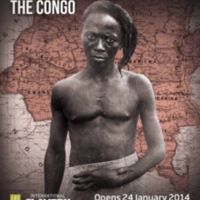
Brutal Exposure, International Slavery Museum, Liverpool (24 January 2015 - 7 June 2015)
This haunting exhibition documented the exploitation and brutality experienced by Congolese people under the control of Leopold II of Belgium in the 1900s. The photographs, by missionary Alice Seeley Harris, were at the time a radical and significant shift in the representation and understanding of the impact of colonial violence in the Congo, and exposed the deep-rooted hypocrisy of so called 'colonial benevolence' which cost the lives of millions of Congolese. The campaign led to public pressure and international scrutiny of Leopold’s administration, which came to an end in 1909.
The legacy of Belgian violence and exploitation would tragically re-emerge years later after the Congo gained independence in 1960, with the murder of the country’s first legally elected Prime Minister, Patrice Lumumba.
European exploitation of the Congolese people and resources has shaped the country's recent history and the effects are still evident today.
This exhibition was developed in partnership with Autograph ABP and Anti-Slavery International.
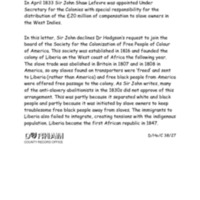
Exhibition to mark the bicentenary of the 1807 Act
Durham Record Office held an exhibition of its original documents relating to slavery, the slave trade and abolition. These include reports, maps, and a number of letters, from, for example, Sir John Shaw Lefevre (Under Secretary for the Colonies in 1833), the abolitionist James Stephen and the prominent Quaker activist Josiah Forster. The exhibition was displayed in the Record Office and toured several venues in the region. It was also used for inspiration by members of Jackass Youth Theatre, who produced the play Sharp Practice after visiting the Record Office and consulting some of the original documents on display.
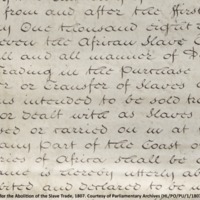
Sticks and Stones Project
The Sticks and Stones Project was led by Northamptonshire Record Office and Northamptonshire Black History Association. A group of students from Kingsthorpe Community College investigated slavery past and present, through historical workshops and a trip to the Houses of Parliament. The focus was on the history of slavery but also learning about forms of modern slavery such as sweatshop labour and trafficking. The students produced a short film and an exhibition to highlight the issues important to young people.